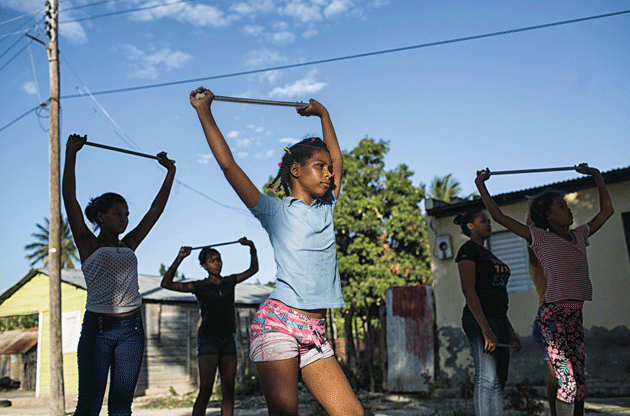Hello and welcome to The Highlighter #105! Today’s issue is titled, The Revenge of The New York Times and The Atlantic Monthly. No matter how much I try to avoid highlighting articles from these esteemed publications — preferring rather to feature pieces from a wide variety of sources — they just ke
Hello and welcome to The Highlighter #105! Today’s issue is titled, The Revenge of The New York Times and The Atlantic Monthly. No matter how much I try to avoid highlighting articles from these esteemed publications — preferring rather to feature pieces from a wide variety of sources — they just keep churning out excellent stuff that warrants our attention.
First up is a poignant and informative article about growing up intersex in the Dominican Republic — my pick of the week. After that there are two articles — one about cell phones, the other about the diet industry — that offer a clear-eyed appraisal of our society today. Then please enjoy a photo break. You all deserve it! Rounding out today’s issue are two articles for teachers and others who care about education. Please enjoy!

The Village Where Girls Turn Into Boys
There is a place in the Dominican Republic where being intersex is normal, where 1 out of 90 people is born with sexual anatomy falling somewhere along a spectrum of biologically male and female. Unlike in the United States, where doctors diagnose intersex babies with a “disorder of sexual development” and most parents opt for surgery, the situation is different in Las Salinas. There, babies born with 5-alpha-reductase deficiency — who are genetically male but sometimes appear female — are generally raised as girls but switch to living as young men as they reach puberty, without much fuss. Author Sarah A. Topol compares sentiments in Las Salinas with those here: “While many of us are quick to endorse inclusivity as a bedrock principle, our society is still rigid when it comes to the construction of gender. We struggle with difference. The first question when a baby is born tends to be: Is everyone healthy? The second is: Is it a boy or a girl?” Thank you to loyal subscriber Jonathan for sharing this article. It’s a great one.
[caption align="alignnone" width="980"]

[/caption]
Have Smartphones Destroyed a Generation?
The headline is clickbaity, sure, but the article itself is solid and worth your time. Author Jean Twenge explains why today’s teenagers hang out less, have less sex, drive less, get pregnant less, smoke less, and are less happy. It’s because they’ve spent most of their lives safely in their bedrooms on their phones keeping up on their Snapstreaks and Instagram stories. As a result, members of Generation Z are significantly different from Millennials. They’re more lonely and more sleep deprived, and there’s little to no way to wrest them away from their iPhones.
Losing It in the Anti-Dieting Age
The weight-loss industry is quickly gaining steam as a popular topic in The Highlighter. In last week’s issue, I highlighted an article about a Weight Watchers cruise. Now comes a full-blown magazine article about Weight Watchers and its attempts to stay relevant in our anti-dieting age. Being thin is out; being healthy is in. Calling someone fat is not OK; calling yourself fat is. What is a weight-loss company to do when it knows how weight loss works but can’t tell its customers the truth?

Why Kids Can’t Write
Here’s a good back-to-school article for all you teachers out there. We know that many young people struggle with writing (and with reading, and with Math, among other things). The question is, What should we do about it? Dana Goldstein (#88), author of The Teacher Wars, describes the current debate on writing instruction: explicit instruction (the Hochman Method), or a process approach focusing on voice (National Writing Project). Ms. Goldstein does not make a recommendation (she’s a reporter), but she summarizes both sides succinctly.
Cal State will no longer require placement exams and remedial classes for freshmen
This is the biggest deal in California secondary education since the state exit examination was suspended last year. Up until a few days ago, nearly 40 percent of students entering the Cal State University system had to take and pass remedial Math and English classes, often without support, that did not offer credit. This requirement, many opponents said, trapped students in a cycle of failure that explained the university system’s dismal graduation rate. (Just 19 percent of students graduate in four years.) No longer.
Podcast Update: I loved this week’s episode with loyal subscriber Angelina! A data guru, Angelina did not disappoint. She grabbed hold of a bar graph in last week’s article on homeless youth in Seattle and didn’t let go! It was wonderful to hear Angelina’s voice about how using data in education is a way for us to get closer, not farther away, from our work with students. If you like the podcast, share it with your friends and subscribe on Apple Podcasts or Google Play. Also, if you want to be a guest on the show, by all means, sign yourself up! I’d be happy to have you.
You’ve reached the end of this week’s edition. Aren’t you sad? Try not to be. Instead, tell your friends about The Highlighter! Also, let’s please welcome new subscribers Jetta, Erica, Scott, and Gia. Have a wonderful week, and I’ll see you back here next Thursday at 9:10 am with another set of great articles.
Join the conversation